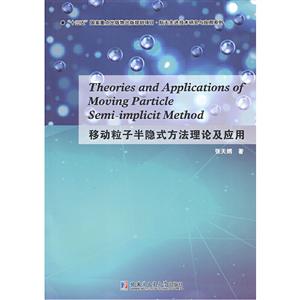“十三五”国家重点出版物出版规划项目·航天优选技术研究与应用系列移动粒子半隐式方法理论及应用(英文) 版权信息
- ISBN:9787560374208
- 条形码:9787560374208 ; 978-7-5603-7420-8
- 装帧:平装-胶订
- 册数:暂无
- 重量:暂无
- 所属分类:>>
“十三五”国家重点出版物出版规划项目·航天优选技术研究与应用系列移动粒子半隐式方法理论及应用(英文) 本书特色
This book systematically introduces the moving particle semi-implicit(MPS) method and its im
provements in the mechanical engineering. The book is composed of six chapters. The first chapter in
troduces the classification of mesh and meshless methods. The second chapter carefully describes the
derivation of the MPS method. Chapter three reviews the different wall boundary conditions used in the
MPS method and emphasizes the polygon wall boundary condition that is an important wall boundaryThis book systematically introduces the moving particle semi-implicit(MPS) method and its im
provements in the mechanical engineering. The book is composed of six chapters. The first chapter in
troduces the classification of mesh and meshless methods. The second chapter carefully describes the
derivation of the MPS method. Chapter three reviews the different wall boundary conditions used in the
MPS method and emphasizes the polygon wall boundary condition that is an important wall boundary
condition widely employed in the industry simulations. Chapter four to six introduces the latest enhance
ments of the polygon wall boundary conditions in the particle number density and the pressure distribu
tions
The book has clear structure and pays attention to the basic theories and derivations. Many newest
research progress of the MPS method are included. The book can be used as the textbook for the post-
graduate students in the field of the mechanical engineering, nuclear engineering, naval
ocean engineering and other relative majors. The researchers and engineers can also study the methods in
the book to conduct industry simulations
“十三五”国家重点出版物出版规划项目·航天优选技术研究与应用系列移动粒子半隐式方法理论及应用(英文) 内容简介
本文系统地介绍了运动粒子半隐式方法及其在机械工程方面的进步。这本书由六章组成。章介绍了网格的分类和无网格方法。第二章详细介绍MPS方法的推导过程。第三章回顾了MPS方法中不同的壁面边界条件,重点介绍了多边形壁面边界条件,这是工业仿真中广泛应用的一种重要壁面边界条件。第四章至第六章介绍了多边形壁面边界条件在粒子数、密度和压力分布方面的近期新进展。该书结构清晰,注重基本理论和推导。介绍了MPS方法的近期新研究进展。
“十三五”国家重点出版物出版规划项目·航天优选技术研究与应用系列移动粒子半隐式方法理论及应用(英文) 目录
- >
企鹅口袋书系列·伟大的思想20:论自然选择(英汉双语)
企鹅口袋书系列·伟大的思想20:论自然选择(英汉双语)
¥8.4¥14.0 - >
小考拉的故事-套装共3册
小考拉的故事-套装共3册
¥36.7¥68.0 - >
新文学天穹两巨星--鲁迅与胡适/红烛学术丛书(红烛学术丛书)
新文学天穹两巨星--鲁迅与胡适/红烛学术丛书(红烛学术丛书)
¥9.9¥23.0 - >
伯纳黛特,你要去哪(2021新版)
伯纳黛特,你要去哪(2021新版)
¥15.9¥49.8 - >
苦雨斋序跋文-周作人自编集
苦雨斋序跋文-周作人自编集
¥6.9¥16.0 - >
诗经-先民的歌唱
诗经-先民的歌唱
¥15.1¥39.8 - >
有舍有得是人生
有舍有得是人生
¥21.2¥45.0 - >
伊索寓言-世界文学名著典藏-全译本
伊索寓言-世界文学名著典藏-全译本
¥6.1¥19.0
-
相对论
¥10.2¥32 -
数学物理方法
¥13.2¥27 -
2022图书×抽奖盲袋
¥9.9¥25 -
2023读书月阅读盲盒——天黑,闭眼,刀谁?
¥42.3¥158 -
2022读者节纪念徽章-三星会员专属
¥45¥45.6



















